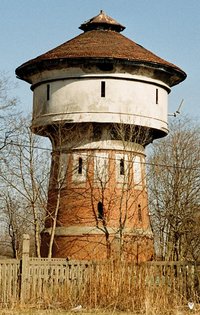Water tower
|
|
A water tower is a very large tank constructed for the purpose of holding a supply of water at a height sufficient to pressurize a water supply system.
A typical water tower in the USA is constructed of either steel, reinforced or prestressed concrete, or brick, is either spherical or cylindrical, is approximately 50 feet (16 metres) in diameter and has a maximum height of approximately 40 feet (13 metres).
The users of the water supply (a town, factory, or just a building) need to have water pressure to maintain the safety of the water supply. If a water supply is not pressurized sufficiently, several things can happen:
- water may not reach the upper floors of a building;
- water may not spray from a faucet with sufficient flow
- without a water tower, parts of gravity flow water supply systems in hilly areas may be subject to negative pressures (see siphon). Negative pressure in the system may cause shallow groundwater to be sucked into a leaky water supply system, polluting it with microorganisms, dirt, sand, fertilizers, and any other toxic contaminants that may be in the groundwater;
The height of the tower provides the hydrostatic pressure for the water supply system, and it may be supplemented with a pump. The volume of the reservoir and diameter of the piping provide sustain and flow rate. However, relying on a pump to provide pressure is expensive; the pump would have to provide a constantly varying output pressure (and thus need an expensive control system), and it would have to be sized sufficiently to give the same pressure at high flow rates. Very high flow rates have been recorded during program breaks during the television broadcast of large sporting events or popular shows.
However, in many countries water towers are taken ot of the water supply system and replaced by pumps only. Many water towers were constructed during the industrial revolution and some of these are now considered architectural landmarks and monuments and may not be demolished. Some are converted to apartments or exclusive penthouses.
Shooters_Hill.JPG
Further Uses
Some water towers are used also as observation towers. There are even water towers with a tower restaurant like the water tower on Goldberg in Sindelfingen. It is also common to use water towers as the location of transmission mechanisms in the UKW range with small power, like for closed rural broadcasting service and portable radio.
The TV Tower Heidelberg originally served also as a water tower. Today it still serves as basic net transmitter of the SWRs for UKW and TV, after 2002 its prospect platform had to be closed due to neccesary rebuilding.
Also the transmitting tower in Waldenburg is used as water tower
Famous water towers in the USA include:
- Chicago Water Tower
- Volunteer Park Water Tower, Capitol Hill, Seattle, Washington
- Warner Bros. Studios Water Tower, Burbank, Los Angeles, California
see also
External Links
- HowStuffWorks.com on Water Towers (http://science.howstuffworks.com/water.htm)
- Photographs of different kinds of water towers in Finland (http://www.muuka.com/finnishpumpkin/towers/tower.html)de:Wasserturm
fr:Château d'eau nl:Watertoren pl:Wieża ciśnień fi:Vesitorni sv:Vattentorn

